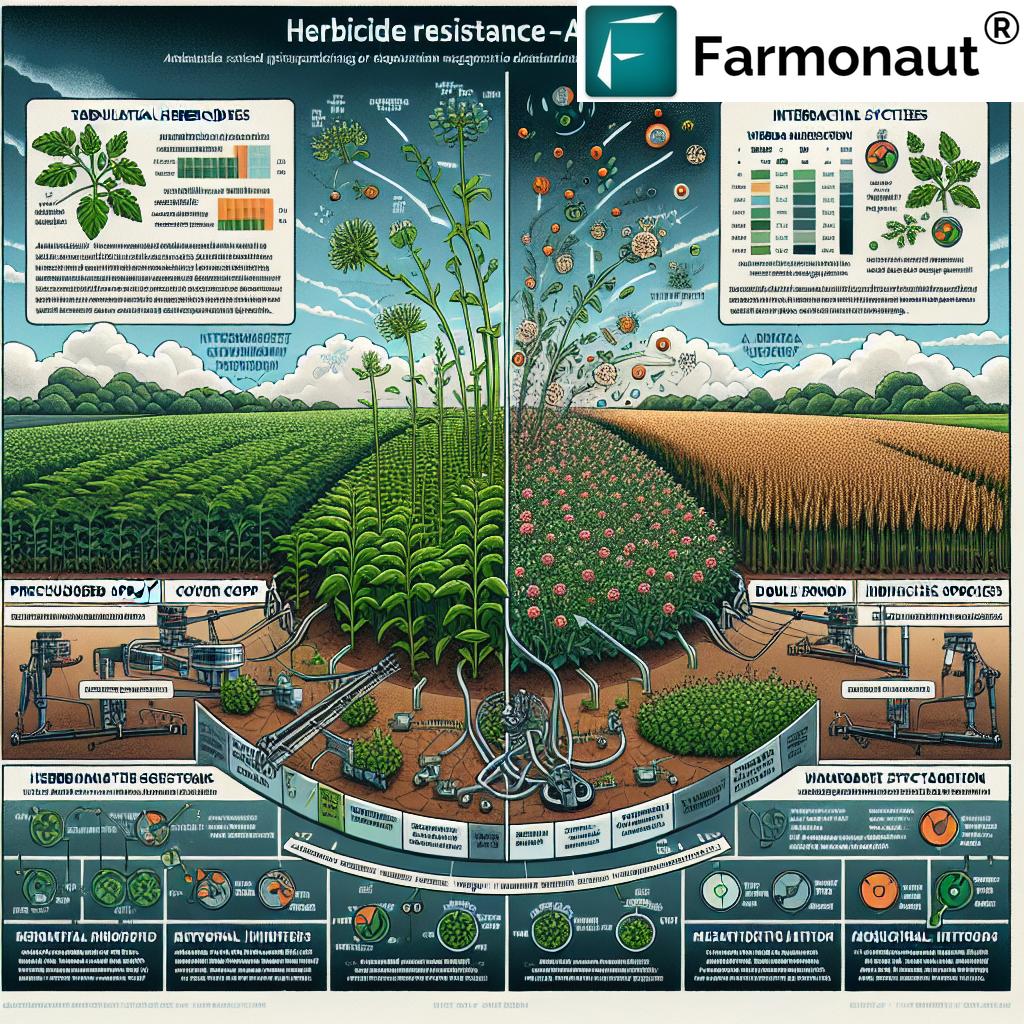Mastering Herbicide Resistance: A Comprehensive Guide to Sustainable Weed Management in Australian Crops
“Group 27 herbicides and HPPD inhibitors are key components in managing herbicide resistance in Australian crops.”
Welcome to our comprehensive guide on mastering herbicide resistance in Australian crops. As experts in agricultural technology and sustainable farming practices, we at Farmonaut understand the critical importance of effective weed management strategies. In this article, we’ll delve deep into the world of herbicide resistance management, exploring cutting-edge techniques and time-tested methods to help Australian farmers combat resistant weeds and protect their crops.

Before we dive into the specifics, let’s take a moment to understand why herbicide resistance management is crucial for Australian agriculture. With the ever-evolving nature of weeds and the increasing pressure on farmers to produce more food sustainably, it’s essential to stay ahead of the curve in weed control techniques.
The Importance of Herbicide Resistance Management
Herbicide resistance is a growing concern in Australian agriculture. As weeds develop resistance to commonly used herbicides, farmers face significant challenges in maintaining crop yields and quality. This resistance can lead to:
- Reduced crop productivity
- Increased production costs
- Environmental concerns due to overuse of chemicals
- Threat to food security
To combat these issues, we need to implement integrated weed management strategies that combine chemical and non-chemical approaches. This is where advanced technologies and sustainable farming practices come into play.
Explore Farmonaut’s satellite-based crop monitoring solutions:
Understanding Group 27 Herbicides and HPPD Inhibitors
Group 27 herbicides, which include HPPD (4-hydroxyphenylpyruvate dioxygenase) inhibitors, have become crucial tools in the fight against herbicide-resistant weeds in Australia. These herbicides work by inhibiting the HPPD enzyme, which is essential for plant pigment production. Let’s explore their benefits and proper usage:
- Broad-spectrum control: Effective against both grass and broadleaf weeds
- Residual activity: Provides extended weed control after application
- Low resistance risk: When used as part of an integrated weed management program
To maximize the effectiveness of Group 27 herbicides and HPPD inhibitors, consider the following guidelines:
- Rotate with herbicides from different mode-of-action groups
- Apply at the recommended rates and timings
- Use in combination with non-chemical weed control methods
- Monitor fields regularly for signs of resistance development
Integrated Weed Management Strategies for Australian Crops
Effective herbicide resistance management requires a holistic approach. Here are some key integrated weed management strategies tailored for Australian crops:
1. Herbicide Rotation
Rotating herbicides with different modes of action is crucial to prevent the development of resistant weed populations. Consider the following best practices:
- Use herbicides from at least three different mode-of-action groups in a growing season
- Avoid using the same herbicide group in consecutive seasons
- Keep detailed records of herbicide applications to plan effective rotations
2. Cultural Techniques
Implementing cultural weed control methods can significantly reduce reliance on herbicides:
- Crop rotation to disrupt weed life cycles
- Increased crop competition through higher seeding rates or narrower row spacing
- Strategic tillage to control weeds before planting
- Cover cropping to suppress weed growth
3. Double Knock Strategy
The double knock strategy involves using two different weed control methods in quick succession:
- Apply a non-selective herbicide (e.g., glyphosate)
- Follow up with a different herbicide or mechanical control method within 1-14 days
This approach is particularly effective for controlling resistant weeds like wild radish and Amaranthus species in broadacre farming.
Enhance your farm management with Farmonaut’s mobile apps:
4. Fallow Management
Effective fallow management is crucial for preventing weed seed set and reducing the weed seed bank. Consider these techniques:
- Use of knockdown herbicides during fallow periods
- Implement strategic tillage to control weeds
- Utilize cover crops to suppress weed growth
- Monitor and control weeds in field margins and non-crop areas
5. Post-emergent Weed Management
Post-emergent herbicide applications are essential for controlling weeds that emerge after crop establishment. To maximize effectiveness:
- Apply herbicides when weeds are small and actively growing
- Use appropriate adjuvants to enhance herbicide efficacy
- Consider tank-mixing compatible herbicides for broader spectrum control
- Monitor weather conditions to ensure optimal application timing
“Double knock strategies and fallow management are effective in combating herbicide-resistant weeds like wild radish and Amaranthus species.”

Sustainable Crop Protection Methods
As we strive for more sustainable agriculture, it’s essential to consider environmentally friendly weed management approaches:
1. Precision Agriculture
Utilizing precision agriculture technologies can help optimize herbicide applications:
- GPS-guided sprayers for accurate application
- Variable rate technology to apply herbicides only where needed
- Remote sensing to identify weed-prone areas
Leverage Farmonaut’s precision agriculture solutions: Satellite and Weather API
2. Biological Control
Exploring biological control options can provide sustainable long-term weed management:
- Use of insects or pathogens that target specific weed species
- Incorporation of allelopathic cover crops to suppress weed growth
- Bioherbicides derived from natural compounds
3. Mechanical Weed Control
Integrating mechanical weed control methods can reduce herbicide dependency:
- Inter-row cultivation in row crops
- Weed seed destruction at harvest using integrated harvesters
- Strategic tillage in conservation agriculture systems
Crop-Specific Herbicide Resistance Management
Different crops require tailored approaches to herbicide resistance management. Let’s explore strategies for some key Australian crops:
1. Broadacre Crops (Wheat, Barley, Canola)
- Implement diverse crop rotations to break weed cycles
- Use competitive crop varieties to suppress weed growth
- Incorporate windrow burning or chaff lining at harvest to destroy weed seeds
- Utilize pre-emergent herbicides with different modes of action
2. Rice
- Practice alternate wetting and drying to control aquatic weeds
- Use benzofenap and other registered herbicides as part of a rotation program
- Implement mechanical weeding techniques in combination with chemical control
- Consider direct-seeded rice systems to allow for different herbicide options
3. Sugarcane
- Use a combination of pre-emergent and post-emergent herbicides
- Implement trash blanketing to suppress weed growth
- Utilize inter-row cultivation for mechanical weed control
- Rotate herbicide modes of action between ratoon crops
Access detailed crop monitoring data with Farmonaut: API Developer Docs
Herbicide Stewardship and Best Practices
Proper herbicide stewardship is essential for maintaining the effectiveness of weed control products and minimizing environmental impact. Here are some key guidelines:
- Follow label instructions: Always adhere to the recommended rates, timings, and application methods
- Calibrate equipment regularly: Ensure accurate and uniform herbicide application
- Use appropriate personal protective equipment (PPE): Protect yourself and others during herbicide handling and application
- Properly dispose of herbicide containers: Follow local regulations for safe disposal
- Maintain buffer zones: Protect sensitive areas and water sources from herbicide drift
- Keep accurate records: Document all herbicide applications for future planning and regulatory compliance
Emerging Technologies and Innovations in Weed Management
The field of weed management is constantly evolving, with new technologies and innovations emerging to help farmers combat herbicide resistance. Some promising developments include:
- AI-powered weed detection: Using machine learning algorithms to identify and target specific weed species
- Robotic weed control: Autonomous machines that can precisely remove weeds without herbicides
- Gene editing: Developing crop varieties with enhanced weed suppression abilities
- Nanoherbicides: Nanoparticle formulations for improved herbicide efficacy and reduced environmental impact
- Hyperspectral imaging: Advanced sensing technologies for early weed detection and targeted control
At Farmonaut, we’re committed to staying at the forefront of these technological advancements, providing farmers with cutting-edge tools for effective weed management and crop protection.
Climate Change and Its Impact on Weed Management
As climate change continues to affect agricultural systems worldwide, it’s crucial to consider its implications for weed management in Australia:
- Shifting weed distributions: Changes in temperature and rainfall patterns may alter weed species’ ranges
- Increased weed competitiveness: Some weeds may become more aggressive under elevated CO2 levels
- Altered herbicide efficacy: Changes in temperature and humidity can affect herbicide performance
- Extended growing seasons: Longer frost-free periods may require adjustments to weed control strategies
To address these challenges, farmers need to adopt flexible and adaptive weed management approaches. This is where precision agriculture tools, like those offered by Farmonaut, can play a crucial role in monitoring and responding to changing environmental conditions.
Herbicide Resistance Management Strategies Comparison
| Strategy | Effectiveness | Sustainability | Crop Suitability |
|---|---|---|---|
| Group 27 Herbicides | High | Medium | Wheat, Barley, Canola |
| HPPD Inhibitors | High | Medium | Corn, Sugarcane |
| Post-emergent Applications | Medium | Medium | Most broadacre crops |
| Herbicide Rotation | High | High | All crops |
| Double Knock Strategy | High | Medium | Wheat, Barley, Cotton |
| Fallow Management | Medium | High | All cropping systems |
Conclusion
Mastering herbicide resistance management in Australian crops requires a multifaceted approach that combines chemical and non-chemical strategies. By implementing integrated weed management techniques, leveraging new technologies, and staying informed about evolving agricultural innovations, farmers can effectively combat resistant weeds while promoting sustainable crop production.
Remember, successful weed management is an ongoing process that requires vigilance, adaptability, and a commitment to best practices. By following the guidelines and strategies outlined in this comprehensive guide, you’ll be well-equipped to tackle the challenges of herbicide resistance and ensure the long-term productivity of your farm.
At Farmonaut, we’re dedicated to supporting Australian farmers with cutting-edge agricultural technology solutions. Our satellite-based crop monitoring tools and AI-driven insights can help you make informed decisions about weed management and overall farm productivity. Explore our range of services and see how we can help you take your farming practices to the next level.
Frequently Asked Questions (FAQ)
- What is herbicide resistance?
Herbicide resistance occurs when weed populations develop the ability to survive herbicide treatments that would normally control them. This happens through natural selection of resistant individuals in a population over time. - How can I prevent herbicide resistance on my farm?
Implement integrated weed management strategies, rotate herbicides with different modes of action, use cultural and mechanical control methods, and follow best practices for herbicide application and stewardship. - What are HPPD inhibitors, and how do they work?
HPPD inhibitors are a class of herbicides that work by blocking the HPPD enzyme in plants, disrupting pigment production and leading to weed death. They are effective against both grass and broadleaf weeds. - How does climate change affect weed management?
Climate change can alter weed distributions, increase weed competitiveness, affect herbicide efficacy, and extend growing seasons. Farmers need to adapt their weed management strategies to these changing conditions. - What is the double knock strategy?
The double knock strategy involves using two different weed control methods in quick succession, typically a non-selective herbicide followed by another herbicide or mechanical control method within 1-14 days. - How can precision agriculture help with weed management?
Precision agriculture technologies, such as GPS-guided sprayers and remote sensing, can optimize herbicide applications, reduce chemical usage, and improve overall weed control efficiency. - What are some emerging technologies in weed management?
Emerging technologies include AI-powered weed detection, robotic weed control, gene editing for enhanced crop competitiveness, nanoherbicides, and hyperspectral imaging for early weed detection. - How often should I rotate herbicides?
It’s recommended to use herbicides from at least three different mode-of-action groups in a growing season and avoid using the same herbicide group in consecutive seasons. - What are some effective non-chemical weed control methods?
Non-chemical methods include crop rotation, increased crop competition, strategic tillage, cover cropping, and mechanical weeding techniques. - How can Farmonaut help with weed management?
Farmonaut provides satellite-based crop monitoring tools and AI-driven insights that can help farmers identify weed-prone areas, optimize herbicide applications, and make informed decisions about weed management strategies.
















